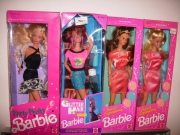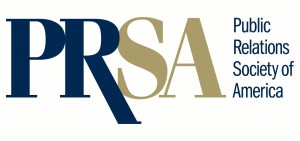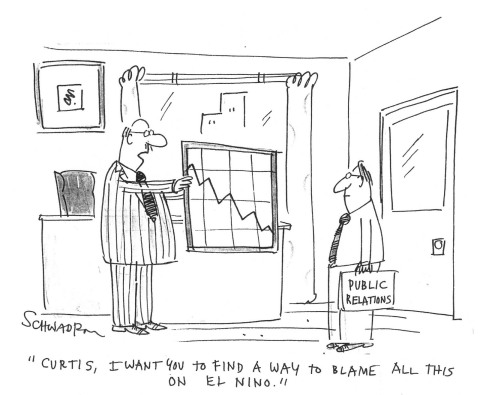Do you ever get stuck, creatively speaking? Ever find yourself frustrated when the words just aren’t flowing the way you want, or not flowing at all? You are not alone. It’s part of the creative pr…
Goofy campaign, or genius marketing strategy?
On a recent drive through northern Virginia back to Philadelphia, I heard a PSA on the radio (somewhere around Fredericksburg, Va.) that caught my attention. This particular announcement was voiced by children who seemed very concerned about the fate of the blue crabs of the Rappahannock River and Chesapeake Bay. Little Johnny and Little Jane were describing the plight of the blue crabs, who apparently are choking and suffocating on fertilizers that wind up in runoff water that channels into the river and eventually the bay.
 Now, I’m a pretty soft touch when it comes to animals and the environment. Do NOT play a Sarah McLaughlin song around me if you don’t want me to immediately weep at the images of beaten and abused dogs and cats that have been permanently impressed into my gray matter through the ASPCA ad campaigns. If you don’t tear up at those images, I can only assume you have a heart of stone. It’s easy to be sympathetic to soft, cuddly animals like cats and dogs, but I also have a great concern for wildlife too. After all, I work at an arboretum and preserving nature and its living systems is part of our mission. However, I never thought before about a blue crab suffering at the bottom of a river, suffocating on toxins that we have shamelessly infused into their ecosystems. And Little Johnny had me ready to stop along the Chesapeake Bay and start dumping what was left of my bottle of water into their little habitats, if only to help diffuse the chemicals. That it was something so ludicrous and so obviously ineffective didn’t matter–I HAD to take action! Little Johnny and the crabs needed my help!
Now, I’m a pretty soft touch when it comes to animals and the environment. Do NOT play a Sarah McLaughlin song around me if you don’t want me to immediately weep at the images of beaten and abused dogs and cats that have been permanently impressed into my gray matter through the ASPCA ad campaigns. If you don’t tear up at those images, I can only assume you have a heart of stone. It’s easy to be sympathetic to soft, cuddly animals like cats and dogs, but I also have a great concern for wildlife too. After all, I work at an arboretum and preserving nature and its living systems is part of our mission. However, I never thought before about a blue crab suffering at the bottom of a river, suffocating on toxins that we have shamelessly infused into their ecosystems. And Little Johnny had me ready to stop along the Chesapeake Bay and start dumping what was left of my bottle of water into their little habitats, if only to help diffuse the chemicals. That it was something so ludicrous and so obviously ineffective didn’t matter–I HAD to take action! Little Johnny and the crabs needed my help!
Then Little Johnny stopped me in mid-fantasy of starting my own blue crab shelter and preserve when he got to the end of his call to action and hit the campaign’s tagline: “No crab should die suffocating in oxygen depleted water. It should be steamed and eaten with Old Bay and melted butter.”
Wait. What?
Did Little Johnny and Little Jane just decry the horrific suffocating fate of blue crabs only to advocate them being steamed alive and eaten? Well, in short, yes they did.
 Forget that I’m not much of a fan of seafood. The announcement made me laugh aloud as I thought about how silly it was to try to save the crabs from one fate, only to subject them to another man-made end. It stuck with me all the way home, how silly these kids sounded and how the marketers obviously used children for a good old tug on the heartstrings–“Oh how wonderful we are! Little Johnny and Little Jane are growing up to be an environmentally-friendly generation. Let’s all pat ourselves on the back.” I started to resent being subjected to–and in fact, pulled in by–the campaign. Didn’t they understand how hypocritical they sounded? I decided this was definitely fodder for a blog post.
Forget that I’m not much of a fan of seafood. The announcement made me laugh aloud as I thought about how silly it was to try to save the crabs from one fate, only to subject them to another man-made end. It stuck with me all the way home, how silly these kids sounded and how the marketers obviously used children for a good old tug on the heartstrings–“Oh how wonderful we are! Little Johnny and Little Jane are growing up to be an environmentally-friendly generation. Let’s all pat ourselves on the back.” I started to resent being subjected to–and in fact, pulled in by–the campaign. Didn’t they understand how hypocritical they sounded? I decided this was definitely fodder for a blog post.
But then something happened. I kept thinking about the PSA. And really, isn’t that what a good campaign strives for? To keep you thinking about something long enough to be converted into taking action? I no longer feel the need to start my own crab preserve, but I can say that after more than a week after hearing one single PSA on the radio, this is a good communication effort. Let’s break it down:
- The campaign is targeted. Obviously, I never heard this PSA outside of the Rappahannock River/Chesapeake Bay area. The people there are very familiar with the crabs, apparently enjoy eating them, and some of those people’s livelihoods actually depend on the crab season.
- While it may seem a little gimmicky to have kids deliver the message, I can say that the change from adults on paid radio advertisements to the sounds of children’s voices effectively cut through my highway hypnosis (an amazing feat in itself) and made me listen. And you know what? It DOES point to a more ecologically- and environmentally-friendly generation, a generation that is making toxin-free food sources a priority.
- It is a coordinated effort. From ads to t-shirts to community partners to a robust website to Facebook to a logo and a “Skip the Fertilizer” slogan AND a documentary, this campaign is hitting all the right notes in a concerted way.
Because this PSA was nagging at me, I decided to Google it and see if there was a website. Sure enough, it was not hard to find and was full of information that was laid out in an easy to navigate. The copy is easy to understand and avoids jargon. And instead of just demonizing the use of fertilizer (I’m an organic kind of girl myself, but this is communications–try to move people into a latitude of acceptance, right?), it offers alternatives to spring fertilizing and even has tips for fertilizing better for your garden and the larger environment. For crying out loud, they even have crab recipes on there. When I checked out the Facebook site, I was surprised to find photos and events and LOTS of user comments and engagement. To my amazement, I even found out that students from Richmond County Public Schools are the kids that are providing the voice over talents for the PSA’s.
 So basically, I have backtracked my stance on this campaign from one of ludicrous hypocrisy, to one of great job on a regional issue. In a way, it reminds me of the Rhett and Link commercials for local businesses. At first look/listen, I thought, “Wow, how could anyone think this is going to attract business?” But when I thought about it some more, those ads are GENIUS in the way they play on stereotypes rampant in locally produced commercials and make them so memorable, that you want to find the business behind the commercial just to meet the people who have such a great sense of humor. Don’t believe me? Check out the Red House Furniture commercial and then try to tear yourself away from watching more Rhett and Link local commercials. This is the crux of today’s issue–create a campaign that, just like melted butter seeping into fresh crab meat, lingers in your audience’s mind enough to make them seek out additional information. That’s when conversions will happen.
So basically, I have backtracked my stance on this campaign from one of ludicrous hypocrisy, to one of great job on a regional issue. In a way, it reminds me of the Rhett and Link commercials for local businesses. At first look/listen, I thought, “Wow, how could anyone think this is going to attract business?” But when I thought about it some more, those ads are GENIUS in the way they play on stereotypes rampant in locally produced commercials and make them so memorable, that you want to find the business behind the commercial just to meet the people who have such a great sense of humor. Don’t believe me? Check out the Red House Furniture commercial and then try to tear yourself away from watching more Rhett and Link local commercials. This is the crux of today’s issue–create a campaign that, just like melted butter seeping into fresh crab meat, lingers in your audience’s mind enough to make them seek out additional information. That’s when conversions will happen.
More than just a box
 I’ve gotten on the Mad Men train and have been powering through the reruns to get caught up. Despite Don Draper’s condescension of public relations in comparison to his chosen profession of advertising, I’ve developed a true love for this show, its complicated layers, well-written characters and plot arcs (check it out!).
I’ve gotten on the Mad Men train and have been powering through the reruns to get caught up. Despite Don Draper’s condescension of public relations in comparison to his chosen profession of advertising, I’ve developed a true love for this show, its complicated layers, well-written characters and plot arcs (check it out!).
 Anyway, during this process, I ran across an episode where the 10-year-old daughter of the main character received a gift from her mother, who claimed it was from Sally’s newborn baby brother, to help her feel more at ease with the new addition to the family. When Betty Draper pulled the gift-wrapped long, rectangular box out from under a pillow, I immediately knew the contents of the box. I caught myself saying out loud, “It’s a Barbie.” When Sally unwrapped it, she found that she was indeed the owner of a new Barbie doll.
Anyway, during this process, I ran across an episode where the 10-year-old daughter of the main character received a gift from her mother, who claimed it was from Sally’s newborn baby brother, to help her feel more at ease with the new addition to the family. When Betty Draper pulled the gift-wrapped long, rectangular box out from under a pillow, I immediately knew the contents of the box. I caught myself saying out loud, “It’s a Barbie.” When Sally unwrapped it, she found that she was indeed the owner of a new Barbie doll.
 There are some brand images that go beyond logos, color palettes and fonts. Barbie is definitely one of them. The simple size and shape of the box was all I needed to see to think back to my own girlhood years and the countless Christmas and birthday gifts I received in boxes exactly like the one Sally received. What I think is most fascinating is the fact that this episode of a fictional television show took place around 1964. I started collecting Barbies roughly 20 years later, and even though the colors and design–even Barbie herself–went through several revisions, the size and shape of that box never changed. Go to any WalMart or Target toy aisle, and there you will find Barbie, another 20+ years later, nestled in the same style box that she started in. I wasn’t even alive in 1964, but all I had to do was see that tidily wrapped box to start thinking back fondly to my own childhood and the various adventures I would invent for Barbie and her friends.
There are some brand images that go beyond logos, color palettes and fonts. Barbie is definitely one of them. The simple size and shape of the box was all I needed to see to think back to my own girlhood years and the countless Christmas and birthday gifts I received in boxes exactly like the one Sally received. What I think is most fascinating is the fact that this episode of a fictional television show took place around 1964. I started collecting Barbies roughly 20 years later, and even though the colors and design–even Barbie herself–went through several revisions, the size and shape of that box never changed. Go to any WalMart or Target toy aisle, and there you will find Barbie, another 20+ years later, nestled in the same style box that she started in. I wasn’t even alive in 1964, but all I had to do was see that tidily wrapped box to start thinking back fondly to my own childhood and the various adventures I would invent for Barbie and her friends.
 Think of a box from Tiffany’s. The size and shape of the box might vary depending on what gift is inside, but the Tiffany blue, the texture of the box, the little white ribbon…it’s all enough to make a girl’s heart skip a beat and know that someone thinks she is special enough to give the very best. The gift inside is icing on the cake, but the fact that it came from Tiffany’s…well, that sets it apart as special and elite.
Think of a box from Tiffany’s. The size and shape of the box might vary depending on what gift is inside, but the Tiffany blue, the texture of the box, the little white ribbon…it’s all enough to make a girl’s heart skip a beat and know that someone thinks she is special enough to give the very best. The gift inside is icing on the cake, but the fact that it came from Tiffany’s…well, that sets it apart as special and elite.
 Sometimes packaging is just as important as the graphics and tag lines on the box and is inseparable from the contents of the package. When I took my nephew to McDonald’s years ago and discovered for the first time that the Happy Meal no longer came in the cardboard box with the little golden arches handles and activities on the sides, I admit I was disappointed. It contained the same food, the same kind of novelty toy for him to enjoy, and it even had activities printed on the paper bag, but it just wasn’t the same. His mean looked very similar to my meal, which also came in a paper bag. It felt as though it was no longer special, even though my nephew never knew the difference.
Sometimes packaging is just as important as the graphics and tag lines on the box and is inseparable from the contents of the package. When I took my nephew to McDonald’s years ago and discovered for the first time that the Happy Meal no longer came in the cardboard box with the little golden arches handles and activities on the sides, I admit I was disappointed. It contained the same food, the same kind of novelty toy for him to enjoy, and it even had activities printed on the paper bag, but it just wasn’t the same. His mean looked very similar to my meal, which also came in a paper bag. It felt as though it was no longer special, even though my nephew never knew the difference.
These examples are all of very iconic products, but I think recognizable packaging had a part in making their product images iconic. Updates and redesigns are nice when attempting to evolve with the times, but know what sentiments your customers might have for different aspects of your product–even something as simple as the box it comes in.
I don’t know if the flirtation with the paper bag was only at that particular McDonald’s location or if it was only for a brief time, but I’m happy to report that the Happy Meal box is back. In fact, check this out to see proposed plans for a Happy Meal box that promotes childhood literacy.
Communicating value in service-oriented businesses, Part 3: Convincing your clients to pay higher prices
Ok, here we are, finally in the promised land of the last installment of this case study series. Here are the important points from Part 2:
- Perception of value is usually very subjective
- Ultimately, value communication exists to raise customers’ willingness to pay for the value they perceive. It is important to determine the type of benefits buyers are seeking from a purchase. Are they looking primarily for economic benefit, i.e. the lowest cost? Or are they looking for psychological benefits such as comfort, status, appearance, pleasure, or personal fulfillment?
- One of the most effective ways to communicate value to psychological benefit seekers is by reframing the way the customer views the product or service differentiation, not in terms of the product’s immediate attribute performance, but in terms of a possible end-benefit
- If customers believe they are getting value for money, they will remain loyal despite price increases
 Now, I’m going to discuss a bit of persuasive theory, but don’t shut down just because it is theory-based. I find that soothing music is my spoon full of sugar for the theory tonic. Right now I’m listening to “That’s the Way” by Led Zeppelin…I highly recommend this soundtrack for your reading/listening pleasure. Besides, this theory is pretty common sense. Here we go…
Now, I’m going to discuss a bit of persuasive theory, but don’t shut down just because it is theory-based. I find that soothing music is my spoon full of sugar for the theory tonic. Right now I’m listening to “That’s the Way” by Led Zeppelin…I highly recommend this soundtrack for your reading/listening pleasure. Besides, this theory is pretty common sense. Here we go…
Many times, customers can be quite difficult when dealing with increases in costs charged to them. As Sherif, Sherif, and Hovland put it, social judgment theory addresses why people can be challenging in these communications and offers a common sense approach to persuasion. This theory classifies attitudes along a continuum (Baldwin, Perry and Moffitt, 2004). Social judgment theory consists of five key principles:
- People have categories of judgment by which they evaluate persuasive positions and each of these positions has three zones—the latitude of acceptance, the latitude of non-commitment, and the latitude of rejection. Before a persuasive argument is even made, each person has their own anchor position, or the most acceptable position for that person.

- When we receive persuasive content, we determine which category a given position belongs in. People do not passively take in information; rather, they make judgments. Naturally, it is easier to influence a person with a larger latitude of acceptance than a larger latitude of rejection.
- A person’s level of ego-involvement, i.e. how important an issue is to a person’s self-identity, affects the sizes of their latitudes.
-

Outside the latitude of accpetance People tend to distort incoming information to fit our categories of judgment depending on the anchor position. If incoming persuasive information falls within the latitude of acceptance and is close to the anchor position, then people assimilate to the new position. Conversely, if it falls outside the latitude of acceptance, then people will contrast that position and make it seem worse than it really is.
- Small to moderate discrepancies between anchor positions and the new advocated position will lead to change; large discrepancies will not. Thus, change is likely to be small and difficult to obtain and will most likely occur slowly over a long period of time (retrieved from http://healthyinfluence.com/wordpress/steves-primer-of-practical-persuasion-3-0/feeling/social-judgment-theory/). Social judgment theory suggests that “major change will not occur within a single message, but that a campaign of several messages, even over a long period of time, might be more helpful” (Baldwin, Perry, and Moffitt, 2004, p. 147).
If the persuasive argument is to raise prices on existing products and services to reflect the intangible value of said products and services, then a probable anchor would be a customer’s reference price. Reference prices are any price set against which other observed prices are evaluated. Reference prices can be internal, contained only in the memory of the consumer, or may be external, determined by market stimuli (such as suggested retail prices) (Chapter 8 PowerPoint, Nova Southeastern University). As pointed out earlier, many consumers do not draw the connection between intangible services and value pricing, so their expectations of pricing based on reference prices may be much lower than what the cost of services actually is.
In their 2004 article, Xia, Monroe, and Cox discuss perceptions of price fairness. They warn that perceptions of price unfairness can lead to repercussions for the seller, including losing clients, a spread of negative information, or other behaviors that might damage the seller’s reputation (Xia, Monroe, and Cox, 2004). The photography industry relies heavily on word-of-mouth referrals, regardless of specialty niche for the photographer. Avoiding perceptions of price unfairness, especially during the somewhat difficult task of raising prices for existing customers, must be avoided. This concept of price fairness is a judgment based in comparisons and typically notions of unfairness are clearer, sharper, and more concrete than feelings of fairness because it can be harder to articulate what “feels” fair (Xia, Monroe, and Cox, 2004).
 A correlation between perceived price fairness and social judgment theory can be drawn. “For price comparison, when the degree of similarity between comparative transactions is relatively high, buyers have little differential information to explain a price discrepancy. The assimilation effect leads consumers to expect or believe that they are entitled to equal prices, and they are likely to judge that the price discrepancy is unfair” (Xia, Monroe, and Cox, 2004, p.4). Because the new price (the persuasive argument) is so close to the reference price (the anchor), the client is likely to think they are being treated unfairly and persuasion does not occur. One can deduce from this that while it is suggested that prices be raised incrementally over time, price changes that are too small and too close to the existing price will not accurately demonstrate the value of the service and will be rejected. The authors also found that price increases that resulted from managerial influence rather than external factors are perceived to be less fair. Trust and id
A correlation between perceived price fairness and social judgment theory can be drawn. “For price comparison, when the degree of similarity between comparative transactions is relatively high, buyers have little differential information to explain a price discrepancy. The assimilation effect leads consumers to expect or believe that they are entitled to equal prices, and they are likely to judge that the price discrepancy is unfair” (Xia, Monroe, and Cox, 2004, p.4). Because the new price (the persuasive argument) is so close to the reference price (the anchor), the client is likely to think they are being treated unfairly and persuasion does not occur. One can deduce from this that while it is suggested that prices be raised incrementally over time, price changes that are too small and too close to the existing price will not accurately demonstrate the value of the service and will be rejected. The authors also found that price increases that resulted from managerial influence rather than external factors are perceived to be less fair. Trust and id
entification between the seller and the buyer also play important roles in perceived fairness of price increases. Behavioral reactions to perceived price unfairness include no action, self-protection, and revenge and each of these buyer behaviors should be avoided when attempting to communicate price increases (Xia, Monroe, and Cox, 2004). This can be accomplished by communicating within the principles of social judgment theory.
So what was the point of all of this?
 As researchers have suggested, multiple price increase campaigns over a long course of time would work best to adjust clients’ attitudes toward new prices. By communicating within their latitudes of acceptance or latitude of non-commitment, Derek Brad Photography will be more effective in increasing prices without sacrificing client relationships. As trust and identification are gained between Derek (the seller) and his B2B and B2C customers (the buyers), it is hypothesized that customer loyalty will win over future incremental price increases.
As researchers have suggested, multiple price increase campaigns over a long course of time would work best to adjust clients’ attitudes toward new prices. By communicating within their latitudes of acceptance or latitude of non-commitment, Derek Brad Photography will be more effective in increasing prices without sacrificing client relationships. As trust and identification are gained between Derek (the seller) and his B2B and B2C customers (the buyers), it is hypothesized that customer loyalty will win over future incremental price increases.
The bottom line:
Because social judgment theory recommends multiple price increases over a long period of time, unfortunately I was unable to get conclusive results during the six-month period of this internship. It would be necessary to do a longitudinal study on Derek Brad Photography to test this hypothesis. However, Derek did proceed with PR tactics based in value communication and has seen increased profits while being able to concentrate more on projects that truly interest him (and pay more), rather than multiple concurrent time-consuming assignments for little to no pay. His reputation as a professional as well as his mission statement have been reinforced by charging prices commensurate with the value he feels his services are worth.
I feel that the culmination of research from this case study and an extended study of the use of social judgment theory in practice with Derek Brad Photography could possibly be used as a model for other small service-oriented businesses.
As always, be sure to subscribe to this blog or check back later for the next installment. We’ll be taking a much-deserved break from the academic stuff and getting back to communication trends, tips, and pitfalls to avoid. You can also follow me on Twitter @laurakate79 or like me on Facebook to join the conversation and get updates. And as if that wasn’t enough, you can also follow me on Google+ and LinkedIn.
One last thank you to Derek Brad of Derek Brad Photography for his cooperation during this case study. If you need a creative and reliable professional photographer, I recommend this guy 100%. Check out more of his work at www.derekbrad.com.




Communicating value in service-oriented businesses, Part 2: Reframing value for maximum profits
Ok, let’s recap:
I did a case study on a small business, Derek Brad Photography, and determined that by constantly low-balling his prices, Derek was inadvertently giving clients the perception that his work was of a lower quality. This was consequently lumping in his professional services with years of experience with amateurs and hobbyists who just use photography as a sideline business rather than a livelihood–definitely an unintended by-product of bargain pricing his services. Industry leaders published research that indicated that three things had to be discovered prior to setting a price for services: 1) Figure out what you provide that sets you apart from your competitors–what value do you bring that no one else does? why should someone hire you?; 2) Discover everything you can about target markets and prospective clients and make sure the services you offer measure up to their needs; and 3) Consider your business’s brand, image, and business model to make sure your prices “fit.”
Awesome. So, now that you recognize that your services have value and your prices have to reflect that, how do you communicate price increases to your existing clients without alienating them and to potential clients without scaring them off? After all, it is very probable that both current clients and possible future clients already have preconceived notions about you working for significantly low prices based on your history. This was certainly the case with Derek.
 Harrison’s public relations research on value (2012) states, “The perception of value is one of the most important elements of pricing. If customers don’t think they are getting value for money, you have no pricing power – you can’t lift prices to maintain profitability without losing many customers. However, if customers believe they are getting value for money, they will remain loyal despite price increases. Value is not just a single element (price); it encompasses a range of attributes of your goods and services for which customers are willing to pay.”
Harrison’s public relations research on value (2012) states, “The perception of value is one of the most important elements of pricing. If customers don’t think they are getting value for money, you have no pricing power – you can’t lift prices to maintain profitability without losing many customers. However, if customers believe they are getting value for money, they will remain loyal despite price increases. Value is not just a single element (price); it encompasses a range of attributes of your goods and services for which customers are willing to pay.”
“Value can be taught” (Vickers, 2008, p. 386). This is an extremely encouraging statement for photographers and other small business owners who struggle with raising prices in a way that will not anger and drive away existing clients who are used to paying lower prices and will not deter potential new clients from engaging their professional services. The author goes on to say, “Viewed in relation to other costs and expenses involved in producing annual reports, magazine ads, brochures, direct-mail pieces, and multimedia shows, a relative commercial value for photographs can be determined and defended using the cool, objective logic of apples-to-apples comparison. Advertising space rates, printing, paper, retouching, design, and mailing costs are available, through some research, for every project that involves photography. But while these costs have steadily climbed, photographers’ fees have declined…They must recognize their value and learn how to negotiate it” (Vickers, 2008, pp.386-387).

According to Berry and Yadav (1996), widespread pricing mismanagement plagues service industries in particular because businesses ignore the special challenges of pricing intangibles. Creativity, lighting expertise, and turn-around times (among the countless other “invisible” conditions that go into creating an effective communication image) are all intangible assets. “The key to improved services pricing is to clearly relate the price that customers pay to the value that they receive. A customer may or may not look for the absolute lowest price available for a service, but everyone wants something worth the price he or she pays (Berry and Yadav, 1996, p.31). Again, as Jackson pointed out, marketers and businesses must first understand what constitutes value for each target market.
NOTE:
This next paragraph is ridiculously important.
The perception of value can vary widely from client to client. The purpose of value communication is to narrow the gap between perceived value and actual value. “Value-based pricing will fail unless customers actually perceive the value that you create and are asking them to pay for…In fact, customers are generally ill-informed about the value of items they buy unless the seller proactively educates and communicates value to them” (Smith, Hogan, and Nagle, n.d.). Ultimately, value communication exists to raise customers’ willingness to pay for the value they perceive. It is important to determine the type of benefits buyers are seeking from a purchase. Are they looking primarily for economic benefit, i.e. the lowest cost? Or are they looking for psychological benefits such as comfort, status, appearance, pleasure, or personal fulfillment (Smith, Hogan, and Nagle, n.d.). These questions relate directly to Jackson’s advice to know your target market and what they value most and will help business owners in deciding effective tactics to use in communicating value of goods and services.
Derek Brad Photography engages in B2B and B2C business. Generally speaking, B2C customers (typically those who purchase prints of their favorite musicians) are looking for economic benefits. B2B customers are more often looking for the psychological benefits of Derek’s talent value because they are marketing to clients of their own and need images that reflect well on the agency and are effective in selling for their clients’ purposes. In the experience of Derek Brad Photography, the clients looking for psychological benefits, i.e. advertising and marketing firms, are willing to pay much higher prices for Derek’s products and services.

Effectively communicating value to psychological benefit seekers can be tricky because the perception of value is usually very subjective. It’s like the beer goggles of marketing. “The key to influencing perceived value for such products is to help buyers make connections between the differentiating features they recognize and the possible psychological benefits they could gain. One of the most effective ways to do this is by reframing the way the customer views the product or service differentiation, not in terms of the product’s immediate attribute performance (‘this razor will give you a closer shave’) but in terms of a possible end-benefit (‘the shave this razor gives you will make you more attractive for an evening out with your date’)” (Smith, Hogan, and Nagle, n.d., p.10). Therefore, it was important while creating the public relations and marketing plan for Derek Brad Photography to choose the most valuable end-benefit that could possibly be associated with choosing Derek for a photographic assignment for each target market segment.
Once a business has a notion of what kind of value it can offer, has examined its target markets for what kind of values they are looking for, sets a price reflective of that perceived value, and can propose the price in terms of end-benefit, how can it overcome preconceived notions about what a price “should” be? Stay tuned for the final installment of this series of posts. Pins and needles, folks!
Be sure to subscribe to this blog or check back later for the next installment. You can also follow me on Twitter @laurakate79 or like me on Facebook to join the conversation and get updates. And as if that wasn’t enough, you can also follow me on Google+ and LinkedIn.
Again, don’t forget to check out Derek’s work at www.DerekBrad.com. Cool stuff!





Communicating value in service-oriented businesses, Part 1: What your prices say about your value
I’m feeling very empowered today–quite possibly because “O Fortuna” from Orff’s Carmina Burana just shuffled onto my speakers (how can you not feel brazen while listening to this classical music gem?!)–so I figure no better time to reveal some of my own research than the present. What follows are highlights and lessons learned from the case study that I engaged in as the final requirement for my Master of Arts in Public Relations (impressed yet?). There are three main points to the thesis of my work, so I’m going to do this as a three-part series of posts, but the crux of it all is about communicating value. Please, hold all applause until the end…
 As part of my graduate capstone project, I had to choose a local small business and shadow their public relations efforts, then make suggestions that could hopefully be used by other small businesses. I interned for Philadelphia music photographer Derek Brad for six months; Derek was interested in expanding his services into more advertising and commercial work. During this time, I observed, spoke at length with Derek, devised questionnaires for him to fill out regarding the nature of his business, and did much of the media and client relations work. This experience gave me enough information to do a thorough business analysis to determine what public relations and marketing efforts were already being done, what could be done better, and what was absent all together. The results would then be used to help me build a PR plan that would ultimately lead to increased profits for this one-man business.
As part of my graduate capstone project, I had to choose a local small business and shadow their public relations efforts, then make suggestions that could hopefully be used by other small businesses. I interned for Philadelphia music photographer Derek Brad for six months; Derek was interested in expanding his services into more advertising and commercial work. During this time, I observed, spoke at length with Derek, devised questionnaires for him to fill out regarding the nature of his business, and did much of the media and client relations work. This experience gave me enough information to do a thorough business analysis to determine what public relations and marketing efforts were already being done, what could be done better, and what was absent all together. The results would then be used to help me build a PR plan that would ultimately lead to increased profits for this one-man business.
 One of the tools I used (and thoroughly believe in) was a SWOT analysis. Easily accomplished, a SWOT analysis merely helps you identify your business or organization’s Strengths, Weaknesses, Opportunities, and Threats–thus, SWOT–in a handy-dandy, easy to read chart format. You can then use the results to maximize your Strengths, lessen or eliminate your Weaknesses, take advantage of new Opportunities, and mitigate Threats before they happen. When I looked at the chart, I noticed that one thing stood out above all others as a recurring issue. Pricing showed up in all columns of the chart with the noticeable exception of Strengths. Thus, I decided to do a case study on how the value of what you (the business owner) offer, expressed through pricing, is non-verbally communicated to your clients and your competitors.
One of the tools I used (and thoroughly believe in) was a SWOT analysis. Easily accomplished, a SWOT analysis merely helps you identify your business or organization’s Strengths, Weaknesses, Opportunities, and Threats–thus, SWOT–in a handy-dandy, easy to read chart format. You can then use the results to maximize your Strengths, lessen or eliminate your Weaknesses, take advantage of new Opportunities, and mitigate Threats before they happen. When I looked at the chart, I noticed that one thing stood out above all others as a recurring issue. Pricing showed up in all columns of the chart with the noticeable exception of Strengths. Thus, I decided to do a case study on how the value of what you (the business owner) offer, expressed through pricing, is non-verbally communicated to your clients and your competitors.
The Professional Photography Industry’s Views on Pricing
As is true with many service-oriented industries, the professional photography industry has been going through quite rapid and game-changing changes (is that redundant?) over the past decade that many professional photographers find difficult to keep up with and remain competitive. With the transition to readily available and affordable digital single lens reflex (DSLR) cameras, amateurs and hobbyists have invaded the photography market, often working for very little monetary compensation for friends and relatives who would otherwise seek out traditional professional photographers.
 In an essay in the ASMP’s Professional Business Practices in Photography (2008), Hermann comments on the state of the professional photography industry by saying, “Digital capture has simultaneously increased the costs of doing business and lowered the bar of entry to our industry” (Hermann, 2008, p.388). She goes on to note that photographers are no longer defined by the equipment they have because pro-sumer products allow clients and subjects frequently to have the same equipment and the relative ease of creating digital montages, slideshows, videos, and interactive media is leading to a shift in the role of still imagery in visual communication.
In an essay in the ASMP’s Professional Business Practices in Photography (2008), Hermann comments on the state of the professional photography industry by saying, “Digital capture has simultaneously increased the costs of doing business and lowered the bar of entry to our industry” (Hermann, 2008, p.388). She goes on to note that photographers are no longer defined by the equipment they have because pro-sumer products allow clients and subjects frequently to have the same equipment and the relative ease of creating digital montages, slideshows, videos, and interactive media is leading to a shift in the role of still imagery in visual communication.
 In the photography industry, as with any other industry, no organization or individual can set pricing standards for your business. It is just plain old illegal. Organizations such as the American Society of Media Photographers (ASMP) had examples and guidelines for pricing, but because the industry is so varied and subjective, it is impossible for ASMP to provide an example for every scenario or product a photographer might encounter and could never take into account every market or regional variance that might affect prices. Enter the dilemma of amateurs flooding the industry. Many photographers have had to rethink their business strategies to cope with this influx of inexperienced pro-amateurs. With pro-ams consistently low-balling bids and undermining the industry standards in pricing, many times it thus becomes necessary for professional photographers to make increases in their price structures and fees. Derek, who in the past had been guilty himself of low-balling a bid or two just to score a gig or get his foot in the door, was struggling to figure out how to submit bids that would recover his Cost of Doing Business (CODB), provide him a profit for his work, and yet be reasonable enough that potential clients would not shy away from engaging his services and existing clients would not be alienated with rate increases…all without compromising the integrity, quality, or creativity of his work.
In the photography industry, as with any other industry, no organization or individual can set pricing standards for your business. It is just plain old illegal. Organizations such as the American Society of Media Photographers (ASMP) had examples and guidelines for pricing, but because the industry is so varied and subjective, it is impossible for ASMP to provide an example for every scenario or product a photographer might encounter and could never take into account every market or regional variance that might affect prices. Enter the dilemma of amateurs flooding the industry. Many photographers have had to rethink their business strategies to cope with this influx of inexperienced pro-amateurs. With pro-ams consistently low-balling bids and undermining the industry standards in pricing, many times it thus becomes necessary for professional photographers to make increases in their price structures and fees. Derek, who in the past had been guilty himself of low-balling a bid or two just to score a gig or get his foot in the door, was struggling to figure out how to submit bids that would recover his Cost of Doing Business (CODB), provide him a profit for his work, and yet be reasonable enough that potential clients would not shy away from engaging his services and existing clients would not be alienated with rate increases…all without compromising the integrity, quality, or creativity of his work.
Are you still with me? We’re about to get to the good stuff.
The Role of Value in Pricing
What elements bring value to photographic services?
 Many consumers tend to overlook the elements that go into the final uniquely creative product of photographers and instead look at the prints or digital images as more of a tangible commodity. However, photography is much more than just the sum of prints and frames and includes multiple intangible elements. As mentioned before, there is the CODB that must be recovered. There is a cost for the amount of time spent preparing for the shoot, at the shoot, and any post-production time spent in editing. A photograph that may have only taken two hours to set up and shoot might have taken a week to storyboard and another eight hours after the shoot to edit, plus the cost of assistants and permits if applicable. There is the intangible element of meeting a deadline (an extremely important element in commercial, editorial, and advertising photography). Also, never underestimate the value in working with a vendor who is simply pleasant to work with (no one likes working with an a-hole)–another intangible element. And, perhaps most importantly, there is the fee associated with a photographer’s unique creativity and perspective that adds an enormous value to the product.
Many consumers tend to overlook the elements that go into the final uniquely creative product of photographers and instead look at the prints or digital images as more of a tangible commodity. However, photography is much more than just the sum of prints and frames and includes multiple intangible elements. As mentioned before, there is the CODB that must be recovered. There is a cost for the amount of time spent preparing for the shoot, at the shoot, and any post-production time spent in editing. A photograph that may have only taken two hours to set up and shoot might have taken a week to storyboard and another eight hours after the shoot to edit, plus the cost of assistants and permits if applicable. There is the intangible element of meeting a deadline (an extremely important element in commercial, editorial, and advertising photography). Also, never underestimate the value in working with a vendor who is simply pleasant to work with (no one likes working with an a-hole)–another intangible element. And, perhaps most importantly, there is the fee associated with a photographer’s unique creativity and perspective that adds an enormous value to the product.
 Understanding how others (such as art directors and creative directors at marketing and advertising firms—clients that Derek hoped to gain) value creativity is important. According to Elsbach and Kramer, “The frequently touted organizational benefits of creativity include higher quality products, more effective decision-making, more integrative solutions to conflicts, better group performance on difficult tasks, and more innovative solutions to organizational problems. Moreover, people associate creativity with a variety of other positive attributes including superior intelligence, humor, and leadership ability” (Elsbach & Kramer, 1998, p. 2). They go on to say that many people in many different professions rely on their personal images of creativity to land jobs, attract financial resources, and garner public acclaim and support from audiences who might appreciate their work (Elsbach & Kramer, 1998). This was particularly true for Derek in trying to break into advertising photography.
Understanding how others (such as art directors and creative directors at marketing and advertising firms—clients that Derek hoped to gain) value creativity is important. According to Elsbach and Kramer, “The frequently touted organizational benefits of creativity include higher quality products, more effective decision-making, more integrative solutions to conflicts, better group performance on difficult tasks, and more innovative solutions to organizational problems. Moreover, people associate creativity with a variety of other positive attributes including superior intelligence, humor, and leadership ability” (Elsbach & Kramer, 1998, p. 2). They go on to say that many people in many different professions rely on their personal images of creativity to land jobs, attract financial resources, and garner public acclaim and support from audiences who might appreciate their work (Elsbach & Kramer, 1998). This was particularly true for Derek in trying to break into advertising photography.
According to Vickers, competition exists in every industry, but in photography the battle is fought primarily at the bottom line. In her essay titled “Value Your Work,” Vickers said, “If photography is to evolve as a profession, we must recognize the value of our product and insist upon fair compensation. Indeed our prosperity revolves around a cycle of value. Photographers must make a collective commitment to maintaining that value” (Vickers, 2008, p.386). She goes on to say that photographers who are aware of their value are far less likely to underbid or compete unfairly, thus undermining the industry as a whole. The same can be said for other service-based professions.
 It is important to note here that there is another aspect to value in pricing that is very common in the photography industry. Price serves as a major signal for quality. “If your billing rate is below market, potential clients will think your work is below market quality. This is because your prices tell the client how to perceive the value of your work” (Orenstein, 2010, pp. 215-216). Think of your own perceptions of the stuff on the clearance aisle at WalMart. Those items are usually there because it is slightly damaged, out of date, or just unwanted at a full price. It is the same with ridiculously low bids and low pricing in services. In fact, this low-balling of prices in the industry is quite rampant and photographers have to remember that it is crowded at the bottom—they will be competing with a huge pool of shooters, particularly pro-ams (professional amateurs) who are just recently stepping into the business. By constantly offering low prices just to score jobs, Derek put himself in the position of giving the perception that his work was less valuable and that he had less experience, thus appealing to bargain shoppers. As this market segment was not the kind of clientele he was aiming for, he had to be willing to raise his prices to reflect his perceived value and then be willing to explicitly explain these price increases to existing customers or potential new customers should they inquire about it.
It is important to note here that there is another aspect to value in pricing that is very common in the photography industry. Price serves as a major signal for quality. “If your billing rate is below market, potential clients will think your work is below market quality. This is because your prices tell the client how to perceive the value of your work” (Orenstein, 2010, pp. 215-216). Think of your own perceptions of the stuff on the clearance aisle at WalMart. Those items are usually there because it is slightly damaged, out of date, or just unwanted at a full price. It is the same with ridiculously low bids and low pricing in services. In fact, this low-balling of prices in the industry is quite rampant and photographers have to remember that it is crowded at the bottom—they will be competing with a huge pool of shooters, particularly pro-ams (professional amateurs) who are just recently stepping into the business. By constantly offering low prices just to score jobs, Derek put himself in the position of giving the perception that his work was less valuable and that he had less experience, thus appealing to bargain shoppers. As this market segment was not the kind of clientele he was aiming for, he had to be willing to raise his prices to reflect his perceived value and then be willing to explicitly explain these price increases to existing customers or potential new customers should they inquire about it.
Self-awareness of professional value and self-worth can only come from within. The same is true for confidence in the value a professional brings to their craft. Derek was aware of his value and believed in it, but lacked the confidence to communicate his worth effectively to potential clients (both B2B and B2C) when it came to pricing.
But I read this blog for communication, not photography. What about the communication?
Glad you asked!
 How does one recognize their value and then communicate it to the client? The first step is careful introspection to figure out what is special about the services that one can offer. Answer questions such as why should someone hire you? What value do you bring that no one else can offer? After this is accomplished, a careful examination of existing and prospective clients and the market a business exists in is absolutely essential (Herrmann, 2008). “A true competitive edge comes from understanding your clients, defining your markets, and offering services that your clients need, want, and are willing to pay for. To accomplish this, you have to learn as much as you can about your prospective clients and markets. You must also examine your offerings with a cold, critical eye to see exactly how your services measure up” (Herrmann, 2008, p. 394).
How does one recognize their value and then communicate it to the client? The first step is careful introspection to figure out what is special about the services that one can offer. Answer questions such as why should someone hire you? What value do you bring that no one else can offer? After this is accomplished, a careful examination of existing and prospective clients and the market a business exists in is absolutely essential (Herrmann, 2008). “A true competitive edge comes from understanding your clients, defining your markets, and offering services that your clients need, want, and are willing to pay for. To accomplish this, you have to learn as much as you can about your prospective clients and markets. You must also examine your offerings with a cold, critical eye to see exactly how your services measure up” (Herrmann, 2008, p. 394).
 Jackson takes this a step further in her article in Professional Photographer magazine. In addition to considering what matters most to clients, she says it is also necessary to consider the business model and the studio’s image or brand. The price that “fits” is one that reflects all three of these elements. Jackson is also clear in saying that copying another photographer’s pricing is counter-productive as these three elements of ideal clients, business model, and brand are as specific to each photographer as the costs of doing business (Jackson, 2013).
Jackson takes this a step further in her article in Professional Photographer magazine. In addition to considering what matters most to clients, she says it is also necessary to consider the business model and the studio’s image or brand. The price that “fits” is one that reflects all three of these elements. Jackson is also clear in saying that copying another photographer’s pricing is counter-productive as these three elements of ideal clients, business model, and brand are as specific to each photographer as the costs of doing business (Jackson, 2013).
In Derek’s case, he found that his expertise in working with fast-moving subjects in poor light or quickly changing, often multi-colored lights during concerts was a significant factor of his professional value. His extraordinarily quick turn-around time on getting images to clients (usually within 24 hours) also set him far apart from his competitors. Finally, his artistic creativity in creating original content put him ahead of the pack of his peers in the Philadelphia area.
But what does it all mean?! You promised communication.
Settle down. Don’t forget that 85% of public relations is research. You HAVE to do your research to craft an effective message.
Ok, so now we’ve identified a bunch of reasons why Derek’s work was valuable. We’ve looked at what made his work special, examined the needs of his target markets and publics, and looked at his brand to make sure the higher prices would “fit.” But how would we communicate all of this (via raising prices) to clients without losing business?
Lucky for you, that is the topic of the next part of this series. And it is GOOD. Be sure to subscribe to this blog or check back later for the next installment. You can also follow me on Twitter @laurakate79 or like me on Facebook to join the conversation and get updates. And as if that wasn’t enough, you can also follow me on Google+ and LinkedIn.
Oh, and don’t forget to check out Derek’s work at www.DerekBrad.com. He’s really got some amazing stuff going on!


 June Divided. Photo by Derek Brad.
June Divided. Photo by Derek Brad.


Watch your mouth! The four letter word of public relations

When I returned to finish my BA in 2008 (while still on active duty in the Air Force), I took a class called Principles of Public Relations from the outstanding Dr. John Forde at Mississippi State University. This was an introductory course for anyone in the public relations track and this was the first strictly PR class I took after switching from broadcasting. We of course learned about the early history of our profession and its leaders, the ethics involved in our practices, and the different specialties that fall under the large umbrella of public relations. All of this stuck with me as a firm foundation for my new career field, but one thing in particular that Dr. Forde said stuck to my gray matter with more tenacity than the rest. He warned, with great emphasis, against using the dreaded and dirty word spin when discussing public relations.
Spin is a four letter word in the world of public relations. It implies that we, the pr professionals, assume that the targeted public is too stupid or too slow to come to the conclusion we want without just telling it straight. It is lazy and it calls into question our credibility. Resorting to spin conveys the idea that we are covering something up, glossing over something, or otherwise just not telling it in a truthful manner. A PR practitioner with no credibility has no persuasive power and thus becomes an ineffectual communicator in our field. We’ve known this since Aristotle first introduced the concept of Ethos to the world, or the appeal to “believe my argument because you believe in me.”
It takes a professional lifetime to build up credibility respective to your different publics, but it only takes a moment to destroy it. I’ve actually heard a handful of pr professionals and marketers use the term “spin” to describe what they do or “spin doctor” to describe themselves in some misguided attempt to seem more important or specialized in their knowledge. This hurts our profession! Are we not masters of persuasive theories and strategies that don’t involve “spinning” a kernel of truth into a manifesto of doubt? Many publics already mistrust our field because they think we are manipulative or some kind of verbal contortionists with the sole purpose of pulling the wool over their collective eyes. We know this isn’t our role; we know that we are integral in the communication process in B2B and B2C organizations. We need to stop giving existing and potential publics the “art of spin” as another reason to mistrust our messages.
In short, there are times when spin is great:
However, when it comes to public relations, always remember:
Too much education and not enough experience? When the PR hiring game turns into the crying game
I saw this Tweet today from @LAPRChick that was retweeted by @WomeninPR1: “Get one Degee and get out of college. You will have all those degrees and no experience and will not get a job. #WIPRCC.”
This short and depressing statement made me mad at first. I mean, after all, if that is the case, then what am I to do with the Master of Arts in Public Relations that I will finish in May 2013 (just a few short months away)? Who did this LAPRChick think she is to pass such swift judgment? And I felt very justified in my reaction.
But when I thought about it a bit longer, I could see the ugly truth in it reflected in my own job search this past year. I have applied for–literally–scores of jobs in the last six months after my internship at the Mann Center for the Performing Arts ended. I have done a total of three internships during my tenure in graduate school, none of which were required for my degree, just so I could continue garnering experience and knowledge assets to make me more competitive in the job search. I went above and beyond in each unpaid internship to make myself a go-to communicator and to ease the transition from my military career to my chosen profession in communication. Yet, here I am, still unemployed.
I started working with a business librarian, Melissa, at my local library who specializes in helping patrons with cover letters and resumes through face-to-face working appointments. I knew that my library offered this service because I used to work there and Melissa is also a friend, but I’m not sure that many people understand the myriad of services that public libraries offer outside of books. One of the best resources that can be found in a library is the librarian–as they say, “Google will help you find a million answers, a good librarian will help you find the right one.” Melissa stressed the “Sell it, don’t say it” philosophy and helped me fine-tune my cover letter and gave me a sample resume to work on the structure we are working toward. In the meantime, I also visited the PRSA website (www.prsa.org) and found some very helpful tips on resume writing for PR jobs in the job resource center, including some creative ideas to make my information stand out and appear technically savvy by incorporating a job search blog, Facebook page, and QR codes to each within my resume.
 Anyway, armed with my new knowledge of resumes and cover letters and, most importantly, a fresh perspective, I took another look at my resume and was dismayed at what I found. Though I had several tactical bullet points regarding strategic experience garnered from my internships, I was not illustrating myself as the poised, mid-management level professional that I am. I finished my undergraduate degree while I was in the military, so even though I started on my BA in Communication in 1997 (thus revealing myself to be older than the average recent graduate), my resume reflects that I graduated in 2010. A careful hiring manager would note that I had over seven years of management experience with a crew of over 20 in a multi-million dollar facility, but only if they connected the dots from my separate education and experience sections. On paper, I was looking like an entry-level rookie in the professional world.
Anyway, armed with my new knowledge of resumes and cover letters and, most importantly, a fresh perspective, I took another look at my resume and was dismayed at what I found. Though I had several tactical bullet points regarding strategic experience garnered from my internships, I was not illustrating myself as the poised, mid-management level professional that I am. I finished my undergraduate degree while I was in the military, so even though I started on my BA in Communication in 1997 (thus revealing myself to be older than the average recent graduate), my resume reflects that I graduated in 2010. A careful hiring manager would note that I had over seven years of management experience with a crew of over 20 in a multi-million dollar facility, but only if they connected the dots from my separate education and experience sections. On paper, I was looking like an entry-level rookie in the professional world.
Ok, so I’m not an entry-level rookie in the professional world. But am I an entry-level rookie in the PR world? I definitely don’t think so, but to get back to the tweet, I’ve been working on my MA for the past three years and have what appears to be very little practical experience (which is definitely not true). There is a disconnect happening between my capabilities and my experience. I think hiring managers might see the word “internship” and immediately think “clip-book” or “fetching coffee” when the reality is so very different. I have analyzed small business practices, developed marketing and PR campaigns, overseen the execution of such plans, been involved in the daily writing tasks associated with an account such as pitch letters, brochures, press releases, media advisories, fact sheets, media kits, etc., been integral in social media campaigns and website maintenance, been an on-site spokesman for businesses and high profile organizations, engaged and managed daily media outreach, nurtured relationships with journalists and clients, analyzed and responded to feedback, evaluated results…the list goes on and on.
My challenge here is to find the correct way to communicate the very hands-on, from-the-bottom-up communication and logistical skills I have been acquiring through my internships that when combined with my MA in PR, make me the go-to, confident, capable public relations manager I know that I am, despite lacking a ton of bouncing from agency to agency entry-level experience most recent grads have. I have another appointment with Melissa for tomorrow to re-tune my resume. I’ll post results in my next post.
 I am not a professional job bouncer. I think that is what my MA says and that is what will set me apart from the recent undergraduates entering the PR field.
I am not a professional job bouncer. I think that is what my MA says and that is what will set me apart from the recent undergraduates entering the PR field.
The oxymoron of 24 hour news
What is news and what makes something newsworthy? I looked it up on dictionary.com and it said, “a report of a recent event; intelligence; information” and “a person, thing, or event considered as a choice subject for journalistic treatment.” I think these are pretty adequate definitions of news.
However, when a subject for “journalistic treatment” has been run into the ground courtesy of 24 hour news outlets, is it really news? Maybe it was initially, but after a while, when there have been no new developments, it really is just the same news story told and re-told by journalists who have to fill their 2-4 hour segment before the next one takes the desk. Journalists must be under extreme pressure to just keep talking just in case someone who wasn’t tuned in two minutes ago might have missed something.
Not only that, I think journalists are also under a huge amount of pressure from the networks to put their “spin” on things just to make it stand out from the rest. We see this happen every day with talking heads and political pundits. Take, for example, the George Zimmerman/Trayvon Martin case. Very little was said about it initially, but after a month had gone by and Zimmerman had not be formally charged with any crime and protests started, the media took it as a sign to run with all sorts of speculations as to why, and of course the speculative experts were called in to weigh in on something that they did not have first-hand knowledge of. Now the media say that the “news” is that George Zimmerman may be unable to get a fair trial. Is that true because of the previous coverage and all of the bias for an against his arrest, or is that because the media just now implanted the idea that he may not be able to receive a fair trial?
This happens all the time due to the nature of the 24-hour news cycle! In fact, I would go so far as to say that calling 24-hour news cycles “news” is a bit of an oxymoron. Look at any bit of the coverage for the GOP presidential candidates. If it is even possible, politicians sound less sincere every day and less knowledgeable about almost everything because they have to deal with media scrutiny in their faces 24/7. In addition to the recycling and recreating of headlines, these same journalists are under a huge amount of pressure to get the story out there first…after all, there is no break in the news coverage on multiple channels. This further leads to getting facts wrong just for the sake of telling the story first.
I appreciate the fact that I can go on the web and look up cnn.com or some other news outlet and get today’s stories when I want them. But part of me really misses the days of newspapers being the most credible sources and television coverage only happening at 6, 12, 6, and 11:00. This seemed to give me a sense that the news had been fact-checked first and it was, in fact, news to me when it was reported.
My question is this: how can we as PR professionals make sure that our message gets out there, yet mitigate the negative issues that come along with 24-hour news coverage?
The power of metrics: How Mississippi State University ranked over Ivy League heavy weights
 First of all, let me start off with saying that I am a proud Mississippi State University alumna. Cut me open, and I’m sure I would bleed maroon and white. I vigorously ring my contraband cowbell at football games and I insist on spelling the shortened version of the mascot as “Dawgs,” just like any other good MSU grad. So it is with a certain amount of glee that I came up with the headline for today’s post. After all, how often does one get to say that MSU outranks several Ivy League schools in anything? And what does this have to do with PR, you ask?
First of all, let me start off with saying that I am a proud Mississippi State University alumna. Cut me open, and I’m sure I would bleed maroon and white. I vigorously ring my contraband cowbell at football games and I insist on spelling the shortened version of the mascot as “Dawgs,” just like any other good MSU grad. So it is with a certain amount of glee that I came up with the headline for today’s post. After all, how often does one get to say that MSU outranks several Ivy League schools in anything? And what does this have to do with PR, you ask?
Well, I came across a great article today that was posted on April 9, 2012 on Track Social Blog (http://tracksocial.com/blog/2012/04/top-universities-on-social-media/) called, “Top Universities on Social Media.” The authors crunched hundreds of metrics for the four pillars of social media marketing, Presence, Audience, Engagement, and Buzz, to determine the top performing universities in the world of social media.
The number 1 spot went to the University of Kansas by clinching the Engagement category during the NCAA playoffs. This school relied heavily on sports coverage, but took it even further by exploiting newsworthy events like the Final Four to mention other things that the school is (or should) be well-known for. According to the article, “KU smartly flooded its Twitter feed with a series of Tweets like: ‘What else at KU is in the top 4 nationally? No. 2 in Hearst awards in journalism (the college ‘Pulitzers’) cc@kujournalism #kubball #KUFacts.‘” The number 2 slot went to Baylor, who used a similar platform for the Engagement category, by capitalizing on the popularity of their women’s basketball team.
 I have seen a similar kind of strategy used by Immaculata University, where I am currently attending graduate school. Though it is a tiny Catholic private school, the majority of their Facebook posts are related to the now-famous Mighty Macs women’s basketball team and the achievements of the lacrosse and baseball teams. MSU does the same with its football, basketball, baseball and soccer endeavors. Universities are commonly linked in public minds with sports, so I see this as a good way to initially engage the audience, but I can totally see the intelligent marketing strategy of schools like the University of Kansas to link the sports achievements to academic accomplishments as well, thus engaging two huge target audiences simultaneously.
I have seen a similar kind of strategy used by Immaculata University, where I am currently attending graduate school. Though it is a tiny Catholic private school, the majority of their Facebook posts are related to the now-famous Mighty Macs women’s basketball team and the achievements of the lacrosse and baseball teams. MSU does the same with its football, basketball, baseball and soccer endeavors. Universities are commonly linked in public minds with sports, so I see this as a good way to initially engage the audience, but I can totally see the intelligent marketing strategy of schools like the University of Kansas to link the sports achievements to academic accomplishments as well, thus engaging two huge target audiences simultaneously.
Number 3 went to Yale University, beating out big brother Harvard who claimed the number 4 status. Yale won out in the Social Presence category by demonstrating its prowess across several social media platforms–Facebook, Twitter, Linked In and YouTube, to name a few. “What Yale has demonstrated is a laudable awareness that establishing a reputation with the next generation will require a great deal of social media savvy. Its robust social strategy – active on all platforms – aims to exhibit the superior achievement that they’ve always been known for, ensuring that the world’s best and brightest will still be clamoring – or Tweeting – for ways to get in,” stated the article.
This is something I’m not very aware of regarding Immaculata. I receive their Facebook updates, but I only just the other day heard about their presence on YouTube. Even if it is out there, if people don’t know about it to check it out, it may as well be absent. And even though IU’s presence is fairly well established on Facebook, the engagement is somewhat lacking. I recently commented with a question about a post regarding commuter students. The administrator immediately came back with a response indicating that they would find out the answer, but they never posted the answer. That was over a month ago. I appreciated the speedy response with the promise to find out the answer, but I resented what came across as a brush-off when the answer was never posted and, I assume, forgotten about. Speaking of their use of Facebook, it was only when I was looking for this particular post that I ran across another post by IU stating that it was now on Pintrest.
What is interesting about Harvard’s social media presence is that it is the birthplace of Facebook and garners top spots in Buzz and Audience categories. It banks on its name and its brand reputation throughout all of its social media exploits. Oh, and check out the Facebook timeline that goes back to 1636, further solidifying its reputation as one of the oldest and most established universities in the U.S.
Well, needless to say, neither MSU nor IU can do that. But what they can do is capitalize on what they do best or the little quirky things that alumni and fans hold on to as dear. For instance, MSU has a huge agricultural department and arguably the best veterinarian school in the southeast. But this is what outsiders see…what MSU Bulldogs know is that South Farm is home to a herd of cows that provide fresh milk for the best cheese and ice cream in the world, which can be bought online and shipped anywhere or sampled fresh at the bakery and cheese shop on campus. Little things like that stick out as fond memories to alumni like myself and these are the kinds of things that online communities thrive around.
So, MSU didn’t outrank Harvard or Yale this year in social media metrics, but it did outrank several other Ivy Leaguers. MSU came in at #25, but it outranked Brown, Georgetown, University of Pennsylvania, Princeton, Vanderbilt, MIT and many others. But as we all know–well, all of us maroon and white-bleeding, cowbell-ringing proud Bulldogs know–none of this compares to outranking #122 University of Mississippi. Can I get a, “Go to hell Ole Miss!” or do I have to wait for the end of the national anthem at the first football game? My fellow Dawgs know what I mean.

















